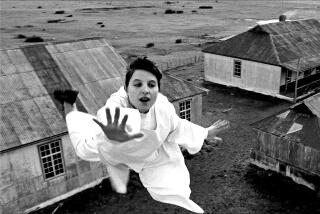‘The Look of Silence,’ which revisits Suharto’s brutality, is sure to shock
“The Look of Silence” is a shocking and significant film, a further illumination of one of recent history’s great horrors, a documentary that will make a difference in the world. It is also an exceptionally difficult film to actually watch.
Directed by Joshua Oppenheimer, “Silence” is a companion piece to his earlier, Oscar-nominated “The Act of Killing,” the first film to bring into focus for Western audiences the nightmare that had overtaken Indonesia starting in 1965.
Within a year after a military coup had put Suharto in power, more than a million people the regime didn’t like, including writers, intellectuals and union members, were labeled as communists and executed.
Though Suharto was driven from office in 1998, his establishment remained in control, and, as the director told Cineaste magazine, when he arrived in Indonesia in 2001, “I had the feeling that I’d wandered into Germany 40 years after the Holocaust only to find the Nazis still in power.”
Oppenheimer spent nearly eight years investigating and filming that world-turned-upside-down situation. Curious about how the perpetrators lived with their acts, he encouraged them to re-create on camera the killings they committed, a surreal endeavor that gave “The Act of Killing” its singularly unsettling dimension.
INDIE FOCUS: Sign up for our weekly movies newsletter
With “Look of Silence,” Oppenheimer wanted to flip the lens, to look at these events from the point of view of the victims who had to live with the pain of those killings in a country where speaking out was still unheard of. He carefully scheduled his filming to take place after he had edited the first film but before it was released, so his contacts within the establishment would still be viable.
Oppenheimer focused on a massacre of 10,500 near the Snake River in Northern Sumatra and specifically on the family of Ramli Rukun, a man whose death was more public than was usual for the military-run executions.
The film spends time with Ramli’s parents, mother Rohani and father Rokun, both over 100 years old and still coping with the pain of their eldest son’s death. “They destroyed so many people,” Rohani says, shaking her head, “but now they enjoy life.”
The protagonist of “Silence” is Adi Rukun, a quiet, dignified optometrist who is Ramli’s younger brother, born after his sibling was killed. As detailed in press notes and interviews (but, frustratingly, not in the film), Oppenheimer has been closely involved with Adi and his family for years, and that closeness is key to the film’s structure.
“The Look of Silence” begins with Adi examining long passages of footage Oppenheimer shot between 2003 and 2005 in which death squad members talk in detail about how they killed not only Ramli but whoever else they could get their hands on.
The graphic, horrific, excruciatingly detailed stories these killers tell take up a major chunk of this film, as they did with “The Act of Killing,” but without the mediating influence of that film’s bizarre re-creations, they are deeply disturbing to sit through.
At a certain point, Adi decides he wants to be in effect a one-man equivalent of the truth and reconciliation commissions that functioned in Rwanda and South Africa, and quietly confront the people who killed his brother.
As Oppenheimer explains in that Cineaste interview, Adi “wanted to know if the perpetrators could acknowledge that what they did was wrong. If they could, and if they could apologize, he could forgive them.”
Those meetings with the perpetrators, made possible by a combination of Oppenheimer’s contacts and Adi’s work as an optometrist (he ends up testing these people’s eyes as a kind of entree), are the most gripping parts of this film, and they do not necessarily end up the way Adi anticipated.
Almost as a rule, the killers tell Adi he is asking too many questions, with the most ominous response a terse “if you make an issue of the past, it will happen again.” Grueling and exhausting though “The Look of Silence” feels at times, this deeply troubling documentary exists because its creators (including numerous Indonesians who worked on it anonymously out of fear) felt no risk was too great to prevent just that from happening.
More to Read
Only good movies
Get the Indie Focus newsletter, Mark Olsen's weekly guide to the world of cinema.
You may occasionally receive promotional content from the Los Angeles Times.






